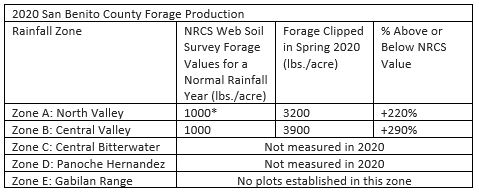This is a summary of forage production clipping from 2020.
I was able to clip forage production at two sites in San Benito County: one in Rainfall Zone A and the other in Rainfall Zone B. Click here to see the Rainfall Zones.
Table 1 shows two forage production values for each rainfall zone. The two forage production values are as follows:
- The NRCS Web Soil Survey estimate of forage production in a normal rainfall year. The NRCS value is considered to be the typical amount of forage that will be produced in a normal rainfall year. Therefore, this year's estimates will be compared to the NRCS estimate.
- Forage production clipped this year (2020).
The last column in the table shows how different this year's production is compared to the NRCS estimate for a normal rainfall year. A plus sign before the number indicates that this year's forage production was higher than the NRCS estimate and a minus sign before the number indicates that this year's forage production was lower than the NRCS estimate.
Table 1. 2020 San Benito County Forage Production
* NRCS forage production data were not available for this site, so forage production from an adjacent soil type was used.
In 2020, forage production in Zones A and B was substantially higher than the NRCS estimates (220% and 290% respectively). Forage production in Zones C, D, and E were not measured.
Forage production was clipped on May 8, 2020. Average annual rainfall (from 1994-2017) for San Benito County according to CIMIS Weather Station #126 in Hollister, was 14.42 inches. CIMIS reported 10.9 inches for this station from October 2019 – May 2020. According to the San Benito County RAWS weather station at Pinnacles National Park, average annual rainfall (from 2001-2017) was 9.83 inches. The Pinnacles RAWS station reported 11.79 inches for from October 2019 – May 2020. Rainfall was lower than average this year in the northern part of the county, but higher than average in the central part of the county. The rainfall started slow this year with no rainfall in October. It rained some in November and picked up in December, but declined again in January. In February as with October, there was no rainfall. March picked up again, with less in April and almost no precipitation in May.
From a grazing perspective, a rancher from the northern part of the county said that the amount and quality of feed for the year were good because of two substantial rain storms that led to a "miracle March." However, there was very little feed early in the season which resulted in calves that were substantially lighter than they would have been in a year with more rain and feed early in the season. A rancher from the central part of the county said this year was probably better than average and that the quality of the feed was good. On the other hand, a rancher from the southern part of the county felt that this year was about average. Although the growth was good, the nutritional quality of the forage was lacking. This rancher started supplementing earlier and heavier than normal.
Author - San Benito County Director and Area Livestock and Natural Resources Advisor
